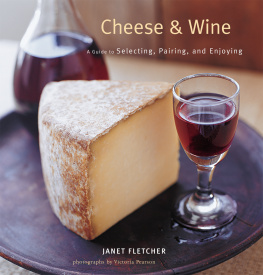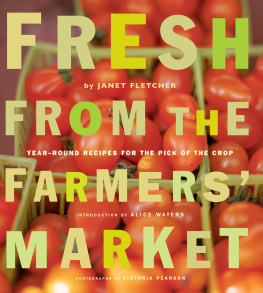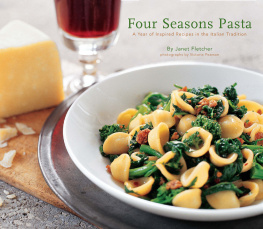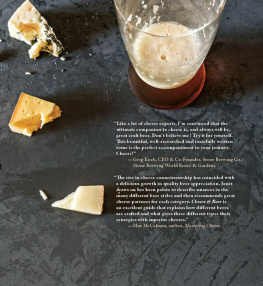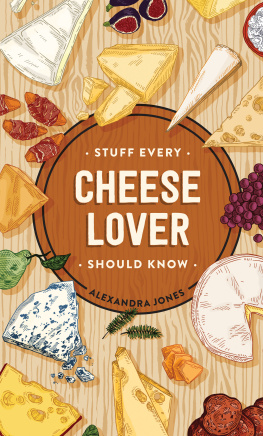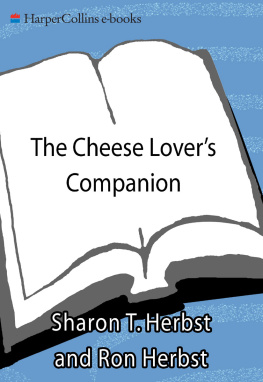Over the centuries, humans have learned to preserve natures seasonal bounty for the times when nature is not so generous. The abundant milk that a cow gives in summer becomes cheese for the winter months. Fresh grapes, which last only days, become wine for future enjoyment. In the temperate climates that nurture both grapevines and dairy animals, it is not surprising that cheese and wine are savored together. Both have long been the daily sustenance of farmers in Spain, France, Greece, and Italy who think of wine and cheese not as fancy foods for entertaining, but as the wholesome heart of an everyday meal.
In America, cheese and wine are too often seen as party food, as something served at a gallery opening or bought only when company is coming. Thats a shame, because although cheese and wine certainly belong on the table when you are entertaining, they are also a pair worth making part of every day.
European cultures provide many models. Who hasnt sighed with pleasure at the sight of the cheese cart in a fine French restaurant? In French homes, the cheese course is more modestperhaps a couple of local cheeses from the farmers market and a baguettebut the daily ritual provides an opportunity to enjoy the last of the dinner wine and linger a little longer at the table. In Spain, friends meet at tapas bars after work for a glass of sherry and a few slices of Manchego. Italians may end a meal with a few chunks of Parmigiano-Reggiano drizzled with balsamic vinegar, or a wedge of Gorgonzola and a glass of passito, a luscious dessert wine.
These time-tested matches never disappoint, but there are many more to explore. With this book, you can begin that voyage of discovery, treating yourself and your guests to those pleasurable moments when a good cheese meets the right wine.

Left to Right: Ldel de Clron and Reblochon
Whether you are choosing wine to accompany a platter of cheeses, or selecting cheeses to enjoy with a favorite wine, the objective is the same: to do no harm to the taste of the wine. When we talk about a successful wine and cheese match, we mean that the cheese or cheeses do not diminish our pleasure in the wine. The wine tastes just as good with the cheese as it does on its own. Occasionally, but not often, a cheese may even enhance a wine.
On the other hand, we rarely need to think about how a wine may affect a cheese. The cheese is the dominant partner in this pairing, and your per ception of it is probably not going to change, no matter what wine you are drinking. For the best outcome, consider the following elements when making your selections:
Texture. Is the cheese creamy and palate-coating or firm and dry? Is the wine a crisp and refreshing Sauvignon Blanc? Or is it a full-bodied and velvety Viognier? Matching textures can be a good strategy, such as pairing a buttery Camellia with a creamy Chardonnay. But contrast also works, as when a triple-crme Brillat-Savarin meets a palate-cleansing sparkling wine.
Intensity. For delicate wines, choose delicate cheeses. More robust wines can handle cheeses with more concentrated flavors. Thats why youthful cheeses fresh goat cheeses, for exampletend to go with youthful wines, like a young Sauvignon Blanc or Chenin Blanc. Likewise, aged cheeses, such as Parmigiano- Reggiano, with their heightened intensity, do best with relatively big, full-bodied wines. One exception: a bold blue cheese may seem to call for a powerhouse red, but that combination is often disastrous. Instead, look to a sweet dessert wine to counter the strength of blue cheeses and avert a flavor clash with the blue mold.
Acidity. Cheeses and wines both have acidity. When you have a cheese of pronounced acidity, such as a Cheddar or Valenay, it is a good idea to counter it with a wine of firm acidity, too.
Sweetness. Cheeses are not literally sweet. With the exception of very fresh cheeses, such as cottage cheese, which may still have unfermented lactose (milk sugar), cheese has no measurable sugar. Nevertheless, we perceive some cheeses as having a sweet or caramel-like finish. Boerenkaas and Lincolnshire Poacher leave this impression. A nutty, off-dry sherry or Madeira can be particularly pleasing with such cheeses.
Mold. The veins of mold in blue cheeses strip most dry white and red wines of their fruit. A sweet wine is almost always the better choice. The more pungent and salty the blue, the richer the dessert wine should be. Curiously, sparkling wines can hold their own with many blue cheeses.
Region. Serving cheese and wine from the same region satisfies us on an emotional level. Indeed, Vellas Dry Monterey Jack with Sonoma County Zinfandel, or Sainte-Maure de Touraine with Vouvray reminds us that some of the best matches are local ones. But dont rely on this guideline uncritically. Many cheeses come from areas where wine isnt produced, and regional matches are not always the best ones.
A few wines present greater challenges for the cheese enthusiast. Heavily oaked wines, especially oaky whites, rarely show well with cheese. Tannic reds also call for caution. They work best with dry, aged cheeses, such as Parmigiano- Reggiano or an aged Manchego or Pecorino Toscano, but are rarely totally satisfying partners for cheese.

Valen
A cheese course doesnt have to be elaborate to be inviting. A single carefully chosen cheese, in perfect condition, is more alluring than a tray loaded with underripe or uninspired selections. A glistening wedge of Manchego served with green olives makes an eye-catching cheese course before dinner. At the end of a meal, a slice of Great Hill Blue garnished with honey and toasted hazelnuts can stand in for dessert.
For most occasions, three cheeses make an ample and generous cheese course for a dinner party. It can be awkward and slow, at a seated dinner, to pass a board with many more selections than that. For a buffet or stand-up party, where the cheese board isnt passed, you can fill it with as many cheeses as your budget allows.
If you are serving more than one cheese, plan your purchases so that you have a complementary assortment. One approach is to assemble cheeses that offer diversity: fresh cheeses and aged ones; mild cheeses and strong ones; a mix of cows, sheeps, and goats milk cheeses; or a variety of styles, such as a bloomy rind, a washed rind, a blue, and a Cheddar. Also consider diversity of shape and color: a tray with a round, a wedge, and a pyramid is more inviting than a tray with three wedges.
Diversity ensures that there is something for everyone and a variety of taste experiences on the tray. On the other hand, it can be enlightening to offer two or three similar cheeses for comparison, such as two aged sheeps milk cheeses, one from Vermont and one from Spain. Wine enthusiasts often compare Pinot Noir or Cabernet Sauvignon from different regions. Why not apply the same principle to cheese?

